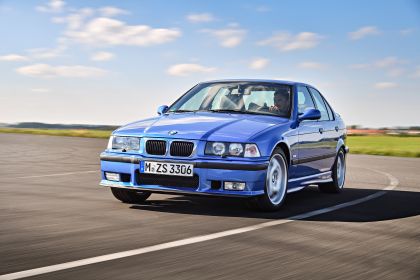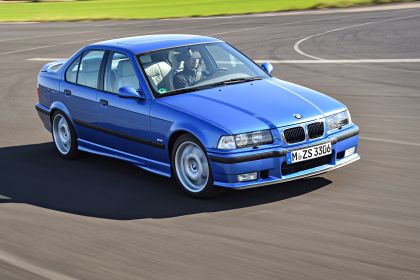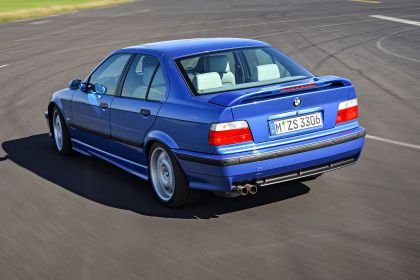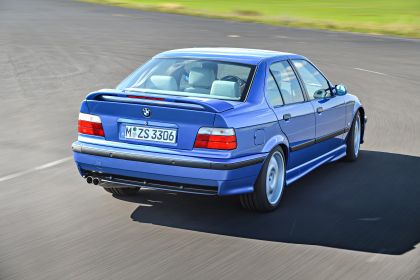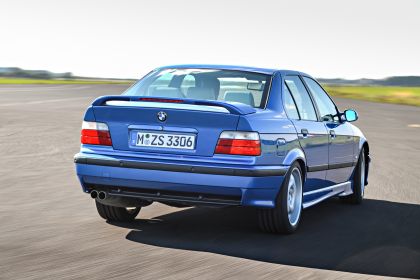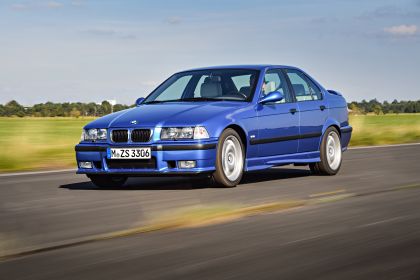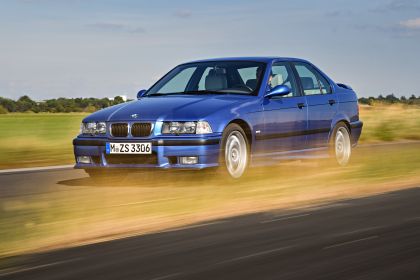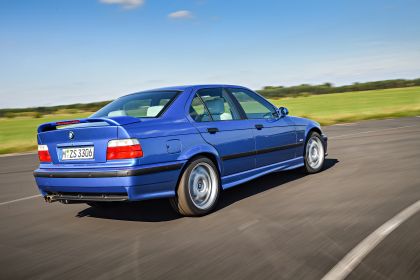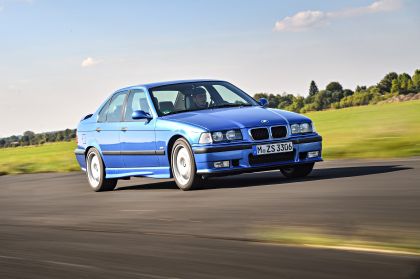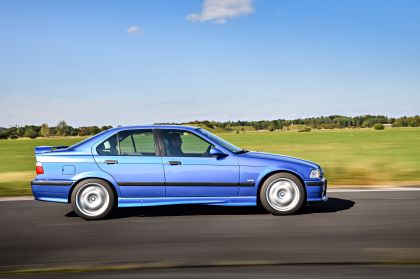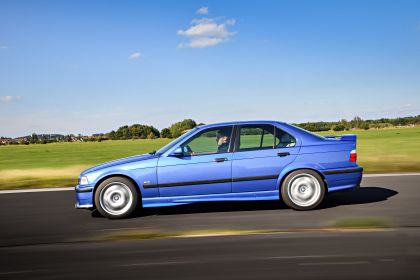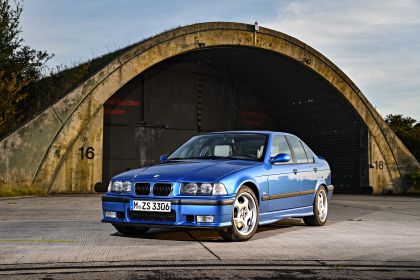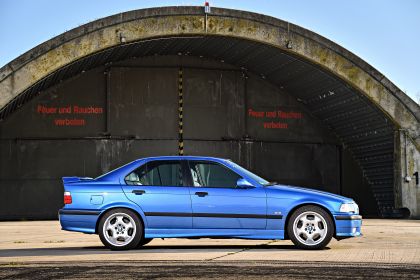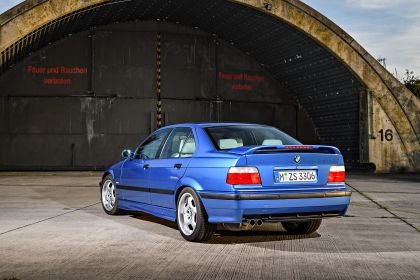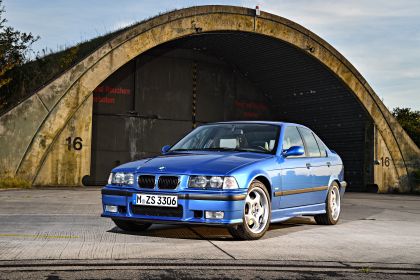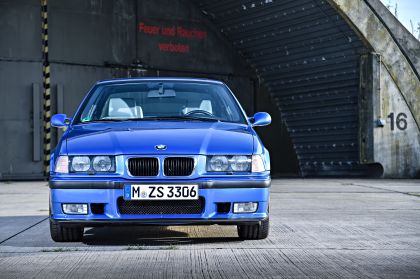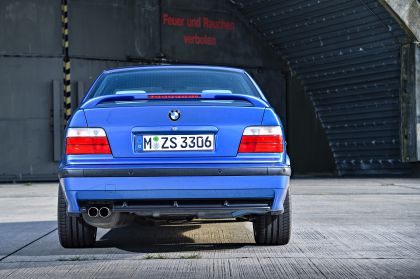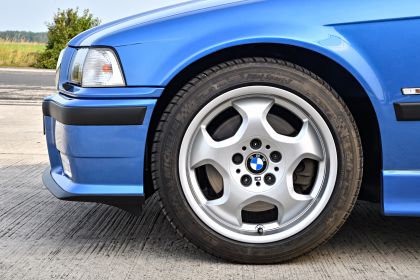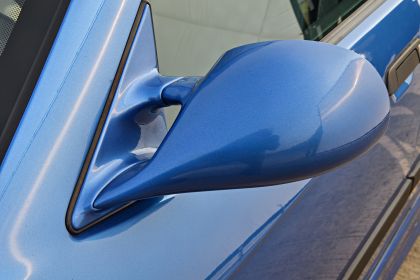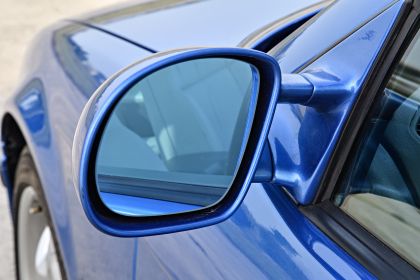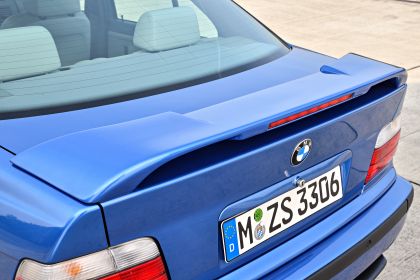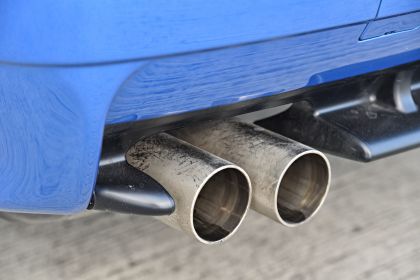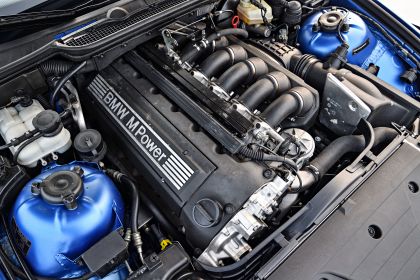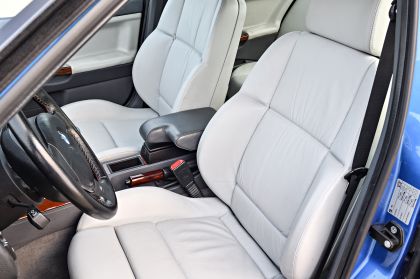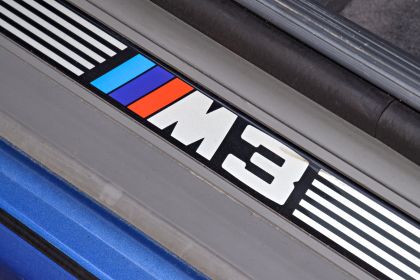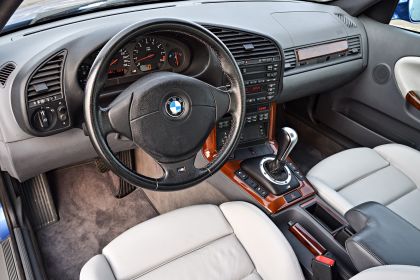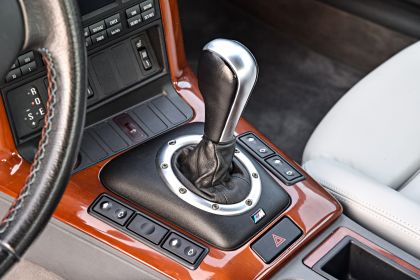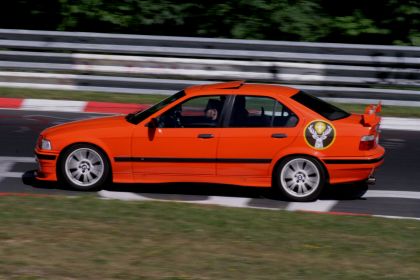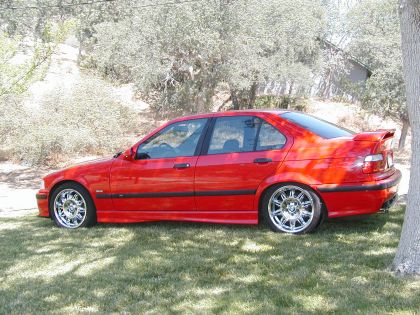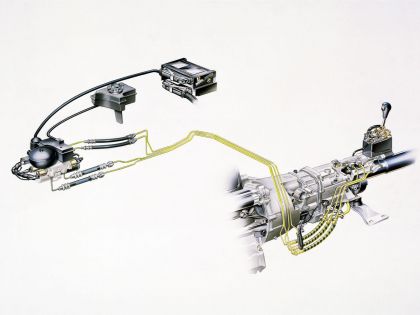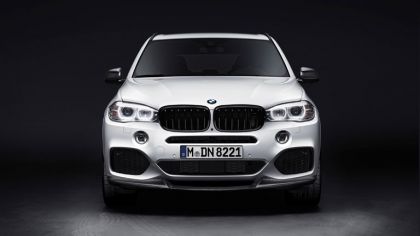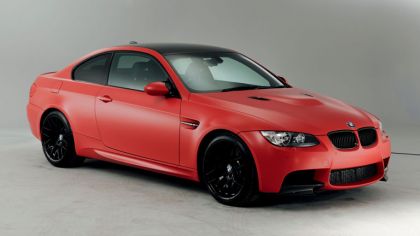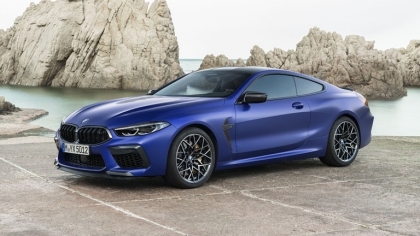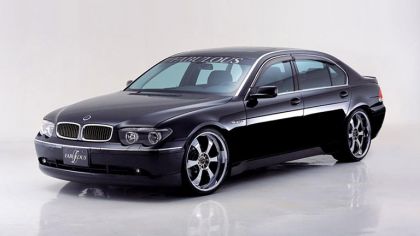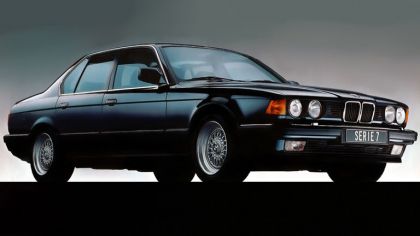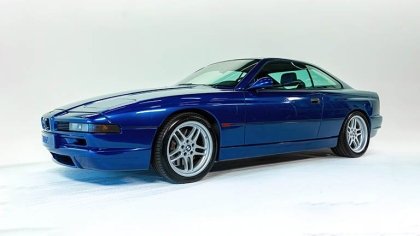Second generation BMW M3 was a completely new car - and a completely different car. This was the end of an era for an uncompromising sports car that was consistently tailored to be competitive in racing and demanded bold qualities from its drivers. An elegant and sophisticated coupé now emerged on the roads with a powerful yet cultured six-cylinder engine. The four-valve engine delivered 210 kW or 286 hp, thanks to the VANOS variable valve timing. This innovation allowed the opening point of the inlet valves to be adjusted to the engine speed and load. The advantage was that torque, power and consumption could be optimised simultaneously. The new M3 engine was a pioneer among naturally aspirated engines generating 320 newton metres at 3600 revolutions. The six-cylinder generated as much power as the previous M3 engine with a peak value of 230 newton metres virtually from idling speed. This made the M3 a world champion. No other naturally aspirated engine had such a high specific output - 97 hp for each litre of displacement - or such a high specific torque - 108 newton metres per litre of displacement. The coupé took 6.0 seconds to sprint from a standing start to a speed of 100 km/h, and the acceleration only stopped at a speed of 250 km/h. This was not because the engine had run out of power but because the electronics brought the acceleration to an end - BMW had set this voluntary limit.
Meanwhile, the DIN consumption values were at a level that would also have looked good on paper for a mid-range car: the BMW M3 used 9.1 litres of super in the Euromix formula. Lead-free was standard because naturally the super sports car had a catalytic converter. The engineers had revised the catalytic converter technology specifically to meet the needs of the new engine and developed the "stereo" oxygen sensors. This allowed the mixture for groups of three cylinders to be regulated separately with an oxygen sensor through separate exhaust systems. It enabled the vehicle to comply with the specified exhaust limits, in fact undercutting them by more than half.
Chassis and brakes: adapted to the performance data
The substantially enhanced engine output of the new model demanded a revision of the chassis and braking system. The result had to be thoroughbred athleticism yet suitable for everyday road use, as well as being specially designed to meet the requirements for 17-inch tyres. Despite the extreme width of the tyres and the 40 section width, BMW M3 customers expected an acceptable level of comfort and good straight-line stability. A key element was once again a single-joint spring strut front axle with reinforced spring plates and axle knuckles. The centrally guided rear axle, used for the first time in the BMW Z1, reduced pitching of the body when driving off and braking to a minimum. Apart from one change involving the longitudinal arm being adjusted to the increased hp. The dampers and anti-roll bars also had to be tuned more tautly. These changes were reflected in the height of the bodywork. The BMW M3 was exactly 31 millimetres lower than a BMW 3 Series Coupé. The values for lateral acceleration also demonstrated how well all the chassis components were tuned to each other. Under normal circumstances, the adhesion limit was reached at a lateral acceleration of 0.8 g - 0.8 times the earth's gravitational acceleration. The chassis of the BMW M3 was subjected to the same intensive tests on the Nürburgring as that of its predecessor, and the value for the new chassis of the BMW M3 came out at an impressive 1 g.
Where powerful forces are being exerted, excessive power needs to be kept under control. The new model was therefore given a particularly powerful braking system with generously dimensioned inner-vented swing-calliper front and rear disc brakes. At that point, ABS systems were already being installed as standard in every BMW, and the ABS for the M3 was specially tailored to the performance of the high-power sports coupé. The result was that the new BMW M3 decelerated from high speeds even more effectively than its predecessor, which had defined benchmarks in this area. At a speed of 100 km/h, the car only needed 2.8 seconds or 35 metres to come to a standstill. Braking from 200 km/h was possible in less than 6.0 seconds.
The mirrors shall be the identifying feature
The new M3 exhibited an understated profile but the car was unmistakable for aficionados. A maw the size of the typical BMW kidney grille opened up under the front bumper and behind the fly guard a generous oil cooler assisted in regulating the temperature of the six-cylinder engine. The BMW M3 had unique, specially developed alloy rims in a double-spoke design and two specially crafted outside mirrors. The mirror housing is attached by two wing-shaped struts to keep drag to a minimum. At the time, these four struts were the ultimate status symbol for coupé drivers. After all, they signalled a coupé with a price tag of 80,000 marks, around one and a half times the price of the two-door 325i as the top-range model for volume production.
Yet the new M3 could be much more than just a sophisticated street sports car. Motorsport GmbH developed a version for competitions in record time starting in April 1992. The new M3 was already lining up on the grid for the first race in the German Touring Car Championship in April 1993. The new regulations were only defined at the beginning of 1992.
M3 GTR wins the Warsteiner-ADAC GT Cup
In April 1993, the new M3 GTR was ready to go in the striking chequered flag design. The six-cylinder packed 325 hp, the car weighed 1300 kilograms in accordance with the regulations. Johnny Cecotto and Kris Nissen took off in the Warsteiner-ADAC GT Cup which Cecotto was ultimately to win at the end of the series. However, this brought the M3 motor-sport chapter to an end for the time being. Changes in the regulations did not leave the powerful BMW 3 Series any real hopes of victory.
Naturally enough, the M3 remained in the winners' class in its civilian life. Readers of sport auto voted the M3 "Car of the year" as the most agile of all 3 Series cars twice in succession, while Auto Plus in France even gave the M3 the accolade of "Car of the century". Immediately after the market launch in the USA, trade journalists from Automobile magazine also awarded the new star in the market the endorsement "Auto of the year" - the first imported car to be granted this title. And this was despite the fact that the BMW M3 - while still very well equipped - had to make do with significantly reduced power for the American market. In order to be certain of complying with US exhaust emission laws, engineers used a 525i engine enlarged to three litres. This engine generated 244 hp in the M3 thanks to the VANOS variable valve timing and generated speeds of up to 220 km/h. It could have packed a bigger punch but the regulations precluded this.
1994: debut of the new BMW M3 convertible
Although the M3 Coupé was elegant and beautiful some customers still had enhanced aspirations. Calls for a new edition of the M3 Convertible became more vociferous. Meanwhile, the motor sport subsidiary company of BMW had been renamed M GmbH and it had anticipated this demand by laying plans for a convertible. In 1994, the new open-top M3 based on the four-seater 3 Series Convertible was launched - fitted with a power-operated hood as standard and innovative safety technology. BMW's rollover protection system provided occupants of the convertible with innovative protection unknown in previous convertibles. In combination with the extremely rigid frame design of the windscreen, two roll-over bars integrated behind the headrests of the rear seats provided protection for passengers if the car rolled over. Sensors monitored the position of the vehicle and released the locking mechanism of the roll-over bars once the limit values were reached. A spring-action mechanism rather than a pyrotechnic device forced the bars out. The newcomer had an enhanced power pack under the body to ensure that high power could be effortlessly transformed into sheer driving pleasure. The convertible weighed some 80 kilos more but this only exerted a minimal effect on performance. Instead of 6.0 seconds, the open-top M3 required precisely 6.2 seconds for the sprint from 0 to 100 km/h. The top speed was the same as the coupé at 250 km/h - and was electronically limited like the coupé. When production ceased in 1999, 12,114 units of the safe and swift BMW M3 Convertible had rolled off the production line.
In 1994, BMW also debuted the four-door saloon. This car enabled BMW to meet the desires of a large number of customers for a compact, luxury saloon with the genes of a high-performance sports car. The four-door car was undoubtedly the most successful combination of sportiness and everyday road use that had been sold up to that point under the M3 badge. This model was particularly attractive to customers who found the convertible and the coupé too sporty and too much of a thoroughbred. The driving characteristics of the saloon were the same as those of the coupé, and the saloon had an impressive profile with the superlative standard interior fittings that featured wood inlays and Nappa leather seats. The production figures told their own story. Up to 1999, 12,435 cars were sold in this body version.
In spring 1995, BMW M GmbH introduced a rather special version when it launched a strictly limited edition as the BMW M3 GT Coupé for homologation. This car was intended to compete on the race track in the IMSA GT Series in the USA. The appeal of this car was for drivers who wanted their BMW M3 to display even more bite. The already generous power was again raised. The special version could only be purchased in the colour British Racing Green. The upgraded 3.0 litre six-cylinder engine now packed 217 kW/295 hp and accelerated the BMW M3 GT to 100 km/h in 5.9 seconds. The aerodynamic design of the vehicle was also revised and now boasted striking spoilers at front and rear. The really special feature was that the angle of the front spoiler could be adjusted by the driver. As far as equipment was concerned, the BMW M3 GT Coupé was a genuine benchmark. Two airbags were included as standard together with sports seats in Nappa leather and carbon-fibre interior trims. The price of the special model manufactured in a limited series of 350 was DM 91,000.
Power boost: more advanced engine with 3.2 litres displacement and 321 hp
Nothing is so good that you can't make it even better. Shortly after the expansion of the M3 stable by the four-door saloon, BMW AG announced on 20 July 1995 that the M3 was getting even more dynamic. The new model could only be distinguished by white indicator lenses, a black cool-air intake in the front spoiler and wheels styled differently from the coupé.
The special feature of the new M3 was the more advanced engine. Firstly, it had a bigger displacement than the existing engine, precisely 3201 cubic centimetres, and hence a good basis for improvement of the key statistics. The maximum torque rose by some ten percent to 350 newton metres while the reference engine speed fell from 3600 rpm to 3250 rpm. The sixcylinder engine with four valves for each cylinder generated 236 kW or 321 hp at 7400 revs. At the same time, the development engineers increased the compression from 10.8 to 11.3, which benefited power and consumption.
All these improvements had been facilitated primarily by the new engine electronics that had been jointly developed by BMW electronics specialists and engineers at M GmbH. Computing power of 20 million commands per second enabled the MSS 50 to calculate the relevant optimum operating data such as ignition point, injection time and knock sensing. It controlled the new double VANOS variable valve timing and managed the adaptive stereo oxygen sensors. And there was much more. This engine management system represented a pioneering step for the subsequent generations of electronic controls.
Double VANOS variable valve timing also for the exhaust camshaft
Improvements continued to be made to power, torque, idling and level of pollutant emissions in the new M3 by installation of an adjustable inlet camshaft. Synchronous control of the exhaust camshaft was also added. This permitted internal exhaust gas recirculation, which significantly reduced nitrogen oxides. However, the variable system also increased the torque in the lower and middle range of engine speeds, generated lower levels of uncombusted gases during idling as a result of less overlap, and thereby assisted in further reducing consumption. The overall effect was that the new M3 consumed 8.7 litres of super in the Euromix formula despite added power. Naturally, the most impressive features were provided by the performance stats of the new M3. The sports car sprinted to 100 km/h in just 5.5 seconds. The explosive performance curve was combined with a high level of elasticity. The sports car needed just 5.7 seconds for acceleration at speed from 80 km/h to 120 km/h in fourth gear. Six-speed gearbox with overdrive.
The engine in the new M3 was not the only area to have a thorough overhaul. The engineers at M GmbH also carried out some intensive work on the power transmission and chassis. For example, they implemented the desire of many M3 customers for an additional drive level with a new six-speed gearbox. The sixth gear exerted an overdrive effect. This reduced revolutions at high speeds, which mainly served to minimise driving noise at very high speeds and cut down fuel consumption.
The chassis sector was - and indeed remains - one of the key domains of each M3. Engineers were mainly working on chassis tuning here. Dampers and spring rates were completely revamped without reducing ride comfort. The servo-assisted rack-and-pinion steering was retained in principle, although the steering effect was transmitted rather more directly and conveyed rather more road contact to the driver than previously.
Unique: M compound braking
The new front axle brake provided a very special highlight that was only otherwise available in this form with the M5: compound braking. The advantage of this system was in the compound design of the aluminium disc brake chamber and the grey cast-iron friction ring. The friction ring was attached to the chamber on a floating mount so that it could expand when braking without becoming distorted. This system provided excellent heat dissipation even at very high temperatures and this additionally exerted a positive effect on the service life.
World first 1997: the first Sequential M Gearbox
Although this had meanwhile become a pure road sports car, it was deriving continual benefit from developments in racing. In 1997, M GmbH was the first automobile manufacturer in the world to market the M3 with the Sequential M Gearbox (SMG) at a premium price. This gearbox offered seamless gear change with the clutch being operated fully automatically. The model for this was the successful BMW 320i touring car. The driver simply pulled back briefly on the selector lever to go up the gears and pushed it forward for downshift. This system delivered extremely short shift times while at the same time preventing the driver from selecting the wrong gear.
The new gearbox combined the easy operation of an automatic with the opportunity for sporty manual gear change and demonstrated a broad array of advantages on the road. On the one hand, the clutch pedal was eliminated, while in contrast to a conventional automatic there was no hydraulic converter with its losses, weights and inertias resulting from the operating principle. Compared with a conventional manual gearshift, there were neither losses in performance values nor efficiency compromises on the basis of the converter slip. Most importantly, the joy of changing gear experienced a tangible enhancement because the Sequential M Gearbox enabled lightning manual gear changes up and down even when the accelerator pedal was floored. The driver no longer had to concentrate on changing gear - high-performance cars in particular demand precise gear changes - and could instead exploit the reserves of the M3 and concentrate entirely on driving.
No wrong gears and no skidding when taking your foot off the accelerator
The Sequential M Gearbox also proved to have many benefits for operational safety. Generally speaking, the driver could no longer select the wrong gear because the system only accepted commands that could be implemented without incurring any danger. The limit to the engine drag torque was defined automatically so that in critical driving situations, for example going down the gears on icy roads, the car didn't go into an uncontrolled skid.
Aside from all the improvements to enhance sporty driving, the SMG also offered further comfort. The automatic clutch made driving in stop-and-go traffic effortless. A second shift level allowed driving in the Economy ("E") level in the same way as an automatic. If peak performance was required, the driver simply had to floor the accelerator and the SMG shifts through to sixth gear. Over-revving the engine during gearshift only took approximately 250 milliseconds. In order to avoid this, the engine control system intervened by adjusting the ignition timing or suppressing one cylinder.
Success story: every second M3 with SMG gearbox
The gearbox took the M3 into new territory in the sport-car sector - and was a runaway success story. A boom followed on from initial scepticism - when production was brought to a close, almost every second M3 in this generation was fitted with an SMG gearbox. The exceptional sports car had become a sales hit. This car rolled off the production line in Regensburg precisely 71,242 times. From 1992 until 1999, it was the silent star in the firmament of the extensive BMW range to be manufactured there - as a coupé, convertible and saloon. The concept was so impressive that two more derivatives joined the M3 in the final two years of production. The M Roadster and the M Coupé had the same engine with identical output, but were otherwise essentially based on the open and closed Z3.

